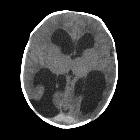Schizenzephalie




























Schizencephaly is a rare cortical malformation that manifests as a grey matter lined cleft extending from the ependyma to the pia mater.
Terminology
Some authors do not use the term schizencephaly, preferring to group these disorders under the blanket term of porencephaly. For the purpose of this article, and generally speaking, schizencephaly is reserved for clefts lined by grey matter (polymicrogyria) thought to represent a true malformation, whereas porencephaly implies an encephaloclastic event (e.g. ischemia).
Epidemiology
Schizencephaly is rare with an estimated incidence of ~1.5:100,000 live births. It is almost always sporadic, although a few familial cases have been described . There is no known gender predilection .
Interestingly, schizencephaly appears to be over-represented in abandoned or adopted children, raising the possibility that in utero insults (e.g. cocaine and other 'street drugs') may be a risk factor .
Clinical presentation
The abnormality is increasingly detected at the antenatal ultrasound, especially when it is of the open-lip variety.
In general developmental delay, motor disturbance correlates with the degree of anatomical abnormality, especially when clefts are present bilaterality. Seizures are relatively common, although the severity and prevalence of seizures do not appear to be dependent on the anatomical extent of involvement.
Pathology
Although exact pathogenesis is uncertain, it is thought most likely to be the result of abnormal neuronal migration. Some authors propose an early in utero vascular insult as the cause. Whether this is from an in-utero insult or the expression of genetic factors is unclear. Some familial cases have been reported, in which case, heterozygous germline mutations of the homeobox gene EMX2 are often encountered .
A cleft extends from the ependymal surface of the brain to the pia mater, and the two layers meet in the cleft: the so-called pial-ependymal seam . The grey matter that lines the cleft is abnormal, usually representing polymicrogyria.
Radiographic features
Schizencephaly can sometimes be bilateral, and is divided into two morphological types:
- open lip
- the cleft walls are separated and filled with CSF
- most common form in bilateral cases
- closed-lip
- the cleft walls are in apposition
- most common form in unilateral cases
Most often the cleft involves the posterior frontal or parietal lobes (70%), and although large clefts can extend to involve the temporal or occipital lobes, isolated involvement of these lobes is uncommon .
It is frequently associated (50-90%) with other cerebral anomalies:
- septo-optic dysplasia
- grey matter heterotopia
- absent septum pellucidum
- dysgenesis of the corpus callosum
Ultrasound
Increasingly, schizencephaly is being diagnosed antenatally or postpartum with cranial ultrasound. Closed lip schizencephaly is hard to identify, whereas open lip forms can, if large, be readily seen (see the article on fetal schizencephaly).
CT
CT can adequately visualize open lip schizencephaly, as well as substantial heterotopic grey matter, but due to an inherent limited ability to distinguish grey from white matter, it is not ideal for fully characterizing congenital abnormalities. The features on CT are the same as on MRI (see below) but merely less well visualized.
MRI
MRI is the imaging modality of choice and enables identification of the pial-ependymal cleft as well as visualization of cortical dysplasia and heterotopic grey matter.
- closed-lip (type I): seen as nipple-like out-pouching at the ependymal surface
- open-lip (type II): heterotopic grey matter-lined CSF cleft seen extending from the ventricular to the cortical surface
Differential diagnosis
- focal cortical dysplasia
- may have a cleft on the cortical surface that does not extend completely to the ventricular surface
- heterotopic grey matter
- assessing the ventricular outline will often demonstrate a slight cleft whereas periventricular grey matter will usually bulge into the ventricle
- porencephaly
- a zone of encephalomalacia that extends from the cortical surface to the ventricular surface but is lined by gliotic white matter, not grey matter
- some authors would refer to schizencephaly as 'true porencephaly'
Siehe auch:
- Arnold-Chiari-Malformation Typ 2
- Heterotopie der grauen Substanz
- Holoprosencephalie
- Septo-optische Dysplasie
- Aquäduktstenose
- Rhombencephalosynapsis
- Fokale kortikale Dysplasie
- fehlendes Septum pellucidum
- Kallmann-Syndrom
- Porenzephalie
- open-lip-Schizencephalie
- kortikale Malformation
- schizencephaly - bilateral
- closed-lip-Schizenzephalie
- Hypoplasie des Nervus opticus
- classification system for midline malformations
und weiter:
- Polymikrogyrie
- neuroradiologisches Curriculum
- Lissenzephalie Typ 2
- differential diagnosis of intracranial cysts in the perinatal period
- Septo-optische Dysplasie mit Schizenzephalie
- unilateral open-lip schizencephaly with absence of septum pellucidum
- Aussackung Liquorräume
- Mikrohydranenzephalie
- Syntelenzephalie
- fetale Schizenzephalie
- Hydranenzephalie

 Assoziationen und Differentialdiagnosen zu Schizenzephalie:
Assoziationen und Differentialdiagnosen zu Schizenzephalie:












